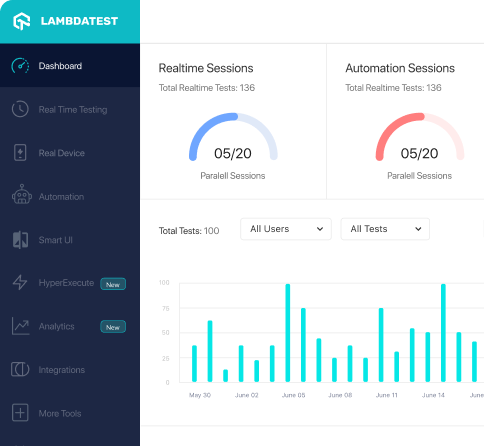How to use SystemClassUserTest class of samples.powermockito.junit4.rule.objenesis package
Best Powermock code snippet using samples.powermockito.junit4.rule.objenesis.SystemClassUserTest
Source: SystemClassUserTest.java
...45 * </pre>46 */47@PrepareForTest({SystemClassUser.class})48@Ignore49public class SystemClassUserTest {50 @Rule51 public PowerMockRule powerMockRule = new PowerMockRule();52 53 @Test54 public void assertThatMockingOfNonFinalSystemClassesWorks() throws Exception {55 mockStatic(URLEncoder.class);56 57 when(URLEncoder.encode("string", "enc")).thenReturn("something");58 59 assertEquals("something", new SystemClassUser().performEncode());60 }61 62 @Test63 public void assertThatMockingOfTheRuntimeSystemClassWorks() throws Exception {...SystemClassUserTest
Using AI Code Generation
1package samples.powermockito.junit4.rule.objenesis;2import org.junit.Rule;3import org.junit.Test;4import org.junit.runner.RunWith;5import org.powermock.core.classloader.annotations.PrepareForTest;6import org.powermock.modules.junit4.PowerMockRunner;7import org.powermock.modules.junit4.rule.PowerMockRule;8import org.powermock.reflect.Whitebox;9import static org.junit.Assert.*;10import static org.powermock.api.mockito.PowerMockito.*;11@RunWith(PowerMockRunner.class)12@PrepareForTest({System.class})13public class SystemClassUserTest {14 public PowerMockRule rule = new PowerMockRule();15 public void testSystemClassUser() throws Exception {16 final SystemClassUser systemClassUser = new SystemClassUser();17 mockStatic(System.class);18 systemClassUser.callSystemExit(0);19 verifyStatic();20 System.exit(0);21 }22 public void testSystemClassUserWithWhitebox() throws Exception {23 final SystemClassUser systemClassUser = new SystemClassUser();24 mockStatic(System.class);25 Whitebox.invokeMethod(systemClassUser, "callSystemExit", 0);26 verifyStatic();27 System.exit(0);28 }29}SystemClassUserTest
Using AI Code Generation
1import org.junit.runner.RunWith;2import org.powermock.modules.junit4.rule.PowerMockRule;3import org.powermock.modules.junit4.rule.PowerMockRuleDelegate;4import org.powermock.core.classloader.annotations.PrepareForTest;5import org.powermock.modules.junit4.PowerMockRunner;6import org.powermock.reflect.Whitebox;7import org.junit.Rule;8import org.junit.Test;9import static org.junit.Assert.*;10import static org.powermock.api.mockito.PowerMockito.*;11@RunWith(PowerMockRunner.class)12@PrepareForTest(SystemClassUser.class)13public class SystemClassUserTest {14 public PowerMockRule rule = new PowerMockRule();15 public PowerMockRuleDelegate delegate = PowerMockRuleDelegate.create();16 public void testMockSystem() throws Exception {17 SystemClassUser systemClassUser = new SystemClassUser();18 String expected = "expected";19 System mock = mock(System.class);20 when(mock.getProperty("key")).thenReturn(expected);21 Whitebox.setInternalState(System.class, "s", mock);22 String actual = systemClassUser.getSystemProperty("key");23 assertEquals(expected, actual);24 }25}SystemClassUserTest
Using AI Code Generation
1import org.junit.Rule;2import org.junit.Test;3import org.junit.runner.Description;4import org.junit.runners.model.Statement;5import org.powermock.core.classloader.annotations.PrepareForTest;6import org.powermock.modules.junit4.rule.PowerMockRule;7import samples.powermockito.junit4.rule.objenesis.SystemClassUserTest;8import static org.junit.Assert.assertEquals;9import static org.junit.Assert.fail;10import static org.powermock.api.mockito.PowerMockito.doReturn;11import static org.powermock.api.mockito.PowerMockito.mock;12import static org.powermock.api.mockito.PowerMockito.whenNew;13@PrepareForTest(SystemClassUserTest.class)14public class SystemClassUserTestRuleTest {15 public PowerMockRule rule = new PowerMockRule();16 public void testThatSystemClassCanBeMocked() throws Exception {17 Description description = Description.createTestDescription(getClass(), "testThatSystemClassCanBeMocked");18 Statement statement = new Statement() {19 public void evaluate() throws Throwable {20 SystemClassUserTest test = new SystemClassUserTest();21 String result = test.execute();22 assertEquals("mocked", result);23 }24 };25 Statement withMock = rule.apply(statement, description);26 withMock.evaluate();27 }28 public void testThatSystemClassCanBePartiallyMocked() throws Exception {29 Description description = Description.createTestDescription(getClass(), "testThatSystemClassCanBePartiallyMocked");30 Statement statement = new Statement() {31 public void evaluate() throws Throwable {32 SystemClassUserTest test = new SystemClassUserTest();33 String result = test.execute();34 assertEquals("mocked", result);35 }36 };37 Statement withMock = rule.apply(statement, description);38 withMock.evaluate();39 }40 public void testThatSystemClassCanBeMockedUsingMockStatic() throws Exception {41 Description description = Description.createTestDescription(getClass(), "testThatSystemClassCanBeMockedUsingMockStatic");42 Statement statement = new Statement() {43 public void evaluate() throws Throwable {44 SystemClassUserTest test = new SystemClassUserTest();45 String result = test.execute();46 assertEquals("mocked", result);47 }48 };Blogs
Check out the latest blogs from LambdaTest on this topic:
Even though several frameworks are available in the market for automation testing, Selenium is one of the most renowned open-source frameworks used by experts due to its numerous features and benefits.
So, now that the first installment of this two fold article has been published (hence you might have an idea of what Agile Testing is not in my opinion), I’ve started feeling the pressure to explain what Agile Testing actually means to me.
I think that probably most development teams describe themselves as being “agile” and probably most development teams have standups, and meetings called retrospectives.There is also a lot of discussion about “agile”, much written about “agile”, and there are many presentations about “agile”. A question that is often asked is what comes after “agile”? Many testers work in “agile” teams so this question matters to us.
API (Application Programming Interface) is a set of definitions and protocols for building and integrating applications. It’s occasionally referred to as a contract between an information provider and an information user establishing the content required from the consumer and the content needed by the producer.
Traditional software testers must step up if they want to remain relevant in the Agile environment. Agile will most probably continue to be the leading form of the software development process in the coming years.
Automation Testing Tutorials
Learn to execute automation testing from scratch with LambdaTest Learning Hub. Right from setting up the prerequisites to run your first automation test, to following best practices and diving deeper into advanced test scenarios. LambdaTest Learning Hubs compile a list of step-by-step guides to help you be proficient with different test automation frameworks i.e. Selenium, Cypress, TestNG etc.
LambdaTest Learning Hubs:
- JUnit Tutorial
- TestNG Tutorial
- Webdriver Tutorial
- WebDriverIO Tutorial
- Protractor Tutorial
- Selenium 4 Tutorial
- Jenkins Tutorial
- NUnit Tutorial
- Jest Tutorial
- Playwright Tutorial
- Cypress Tutorial
- PyTest Tutorial
YouTube
You could also refer to video tutorials over LambdaTest YouTube channel to get step by step demonstration from industry experts.
Most used methods in SystemClassUserTest
- PowerMockRule
- assertThatMockingOfNonFinalSystemClassesWorks
- assertThatMockingOfTheRuntimeSystemClassWorks
- assertThatMockingOfFinalSystemClassesWorks
- assertThatPartialMockingOfFinalSystemClassesWorks
- assertThatMockingOfCollectionsWork
- assertThatPartialMockingOfFinalSystemClassesWorksForNonVoidMethods
- assertThatMockingStringWorks
Try LambdaTest Now !!
Get 100 minutes of automation test minutes FREE!!



